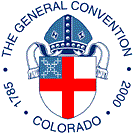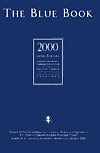![]()
![]()
DO REALISE THIS PRIMER IS entirely unofficial, although we believe it to be reasonably accurate. We offer this overview in the hope that it will give our readers a basic idea of how General Convention works.
![]()
 It's
large.
It's
large.
ECUSA's General Convention is purportedly the largest legislative body
in the world. It's bicameral—modelled on the structure of the US
Congress—with two houses that meet concurrently: the House of Clerical
and Lay Deputies and the House of Bishops. At present the House of Deputies
has roughly 800 sitting members and the House of Bishops around 300. In
the Episcopal Church, retired bishops of the church have voice and vote
at Convention, a practice, as far as we know, that is followed by no other
governing body in the Anglican Communion. The Houses meet and act separately,
and both must concur in order to adopt legislation. In other words, if
the House of Deputies passes a particular resolution but the House of
Bishops does not, the resolution will not become an Act of Convention.
It's democratic.
Individual deputies may write and submit resolutions, as can bishops,
dioceses, and entities of General Convention itself (commissions and the
like). Once
submitted, resolutions are assigned to am appropriate legislative committee,
and in the hands of these committees lies the fate of any given resolution.
Committees can hold hearings for public comment on resolutions, they can
reword or amend a resolution, they can combine two resolutions, decide
not to report a resolution out of committee for consideration by the appropriate
house
(thereby effectively killing it), or they can report it out of committee
to be put on the legislative calendar for consideration by the house where
the resolution was initiated. Committees are parallel for each house,
but in recent years they have met together as cognate committees; for
example, there are two committees for World Mission, one composed of lay
and clerical deputies and one of bishops, but they meet together.
|
|
|
(Click here for a readable image. Or an even better image, about 100K.) |
It's powerful.
'The General Convention alone has authority to amend the Book of Common
Prayer and the Episcopal Church's Constitution, to amend the Canons of
the Church, and to determine the program and budget of the Convention
itself and whatever missionary, educational and social programs it authorizes.
It receives reports from various church committees and agencies, formulates
policy, and elects half the forty members of the Executive Council which
administers policy and program between the triennial gatherings of the
Convention'.
It's got
deputies, not delegates.
Those elected to the House of Clerical and Lay Deputies by their dioceses
are indeed 'deputies', not delegates. It's a crucial difference, in that
deputies are elected to represent their dioceses, but are entrusted to
vote their consciences. They do not serve as a mere voters for the most
dominant perspectives in their dioceses, but are ideally people entrusted
with the support and prayers of their dioceses to act and vote as seems
best at General Convention. Throughout convention, men and women on the
floor of the House are addressed as 'Deputy [Surname Here]', no matter
how distinguished their titles outside General Convention.
 |
|
Now online |
It's a
fascinating mix of people.
Although there is no official online roster of the houses, Louie Crew
has assembled fascinating information about the people who compose the
seventy-third General Convention. See his profiles of the House
of Deputies and the House
of Bishops.
It already
has work to do.
Here are resolutions submitted before the start of the convention ('pre-filed'). You can see the proposed actions that various individuals
and bodies have suggested that the church take. The 'Blue Book'
contains all the background information and documents that deputies and bishops need for General Convention. This year that is online,
as are the Constitution and Canons of the Episcopal Church.
More information
The official site for
General Convention 2000 and the Office
of the General Convention official
web site will provide you with additional information. A
general
calendar of General Convention is also online.
![]()
Back
to Anglicans Online General Convention 2000 home
page